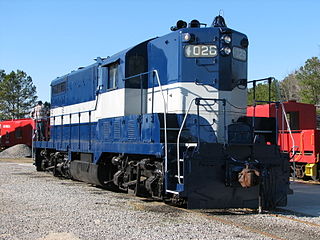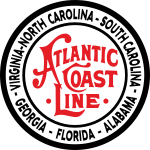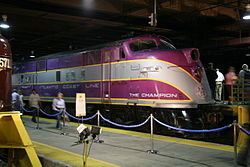
The Seaboard Coast Line Railroad was a Class I railroad company operating in the Southeastern United States beginning in 1967. Its passenger operations were taken over by Amtrak in 1971. Eventually, the railroad was merged with its affiliate lines to create the Seaboard System in 1983.

The Seaboard Air Line Railroad, which styled itself as "The Route of Courteous Service", was an American railroad that existed from April 14, 1900, until July 1, 1967, when it merged with the Atlantic Coast Line Railroad, its longtime rival, to form the Seaboard Coast Line Railroad. Predecessor railroads dated from the 1830s and reorganized extensively to rebuild after the American Civil War. The company was headquartered in Norfolk, Virginia, until 1958, when its main offices were relocated to Richmond, Virginia. The Seaboard Air Line Railway Building in Norfolk's historic Freemason District still stands and has been converted into apartments.

The Georgia Railroad and Banking Company also seen as "GARR", was a historic railroad and banking company that operated in the U.S. state of Georgia. In 1967 it reported 833 million revenue-ton-miles of freight and 3 million passenger-miles; at the end of the year it operated 331 miles (533 km) of road and 510 miles (820 km) of track.
The Wilmington and Weldon Railroad (W&W) name began use in 1855, having been originally chartered as the Wilmington and Raleigh Railroad in 1834. When it opened in 1840, the line was the longest railroad in the world with 161.5 miles (259.9 km) of track. It was constructed in 4 ft 8 in gauge. At its terminus in Weldon, North Carolina, it connected with the Seaboard and Roanoke Railroad and the Petersburg Railroad. The railroad also gave rise to the city of Goldsboro, North Carolina, the midpoint of the W&W RR and the railroad intersection with the North Carolina Railroad.
The Richmond and Petersburg Railroad moved passengers and goods between Richmond and Petersburg from 1838 to 1898. It survived the American Civil War and eventually merged into the Atlantic Coast Line Railroad in 1900.
The Atlantic Coast Line Railroad was a US Class I railroad from 1900 until 1967. The following former and active train stations were previously used by the Atlantic Coast Line Railroad. Many of them are listed on the National Register of Historic Places.

The Champion was a streamlined passenger train operated by the Atlantic Coast Line Railroad and Florida East Coast Railway between New York City and Miami or St. Petersburg, Florida. It operated from 1939 until 1979, continuing under the Seaboard Coast Line and Amtrak. It was a direct competitor to the Seaboard Air Line Railway's Silver Meteor, the first New York-Florida streamliner.
The South Wind was a named passenger train equipped and operated jointly by the Pennsylvania Railroad, the Louisville and Nashville Railroad, the Atlantic Coast Line Railroad, and the Florida East Coast Railway. The South Wind began operations in December 1940, providing streamliner service between Chicago, Illinois and Miami, Florida. This was one of three new seven-car, all-coach streamliners operating in coordination every third day along different routes between Chicago and Miami. The other two longest enduring Chicago-Florida trains were the City of Miami and the Dixie Flagler. The South Wind remained in service through the creation of Amtrak in 1971.

The Vacationer was a seasonal passenger train operated by Amtrak between New York City and Miami, Florida. The Vacationer, like its predecessor the Florida Special, was designed to supplement regular Northeast—Florida service during the winter months. It made its final run on March 31, 1974. The Florida Special dated back to 1888; the Vacationer originated in 1938.
The Jacksonville & Southwestern Railroad (J&SW) was a railroad that served Florida from 1899 to 1904. It was purchased by the Atlantic Coast Line Railroad in 1904. The Atlantic Coast Line would extend the line further west and it would become their Jacksonville—Wilcox Line. Some of the original right-of-way was converted to a recreational path in the rails to trails program in the 1990s.
The Florida Western and Northern Railroad was a subsidiary of the Seaboard Air Line Railroad that expanded their network in the 1920s by building a rail line from Coleman, Florida all the way to West Palm Beach via Auburndale and Sebring, a distance of 204 miles. The line would be extended to Miami by the Seaboard-All Florida Railway, another Seaboard Air Line subsidiary, shortly after with the full line from Coleman to Miami becoming the Seaboard Air Line's Miami Subdivision. The line is still in service today from Auburndale to West Palm Beach and is now operated by Seaboard successor CSX Transportation as their Auburndale Subdivision.

The Dixie Flyer was a premier named passenger train that operated from 1892 to 1965 via the "Dixie Route" from Chicago and St. Louis via Evansville, Nashville, and Atlanta to Florida. However, the train continued until 1969 as an Atlanta to Florida operation, run solely by the Atlantic Coast Line Railroad and its successor, the Seaboard Coast Line. The Flyer's route varied in early years, but by about 1920 was set as follows:
The Wildwood Subdivision is a railroad line owned by CSX Transportation in Florida. It runs along CSX's S Line from Baldwin south to Zephyrhills via Ocala and Wildwood for a total of 155.7 miles. The S Line is CSX's designation for the line that was the Seaboard Air Line Railroad main line from 1903 to 1967.
The Norlina Subdivision is a railroad line owned by CSX Transportation in the U.S. State of North Carolina. The line currently runs from Norlina, North Carolina, to Raleigh, North Carolina, for a total of 51.2 miles. At its north end the line comes to an end and at its south end the line continues north from the Aberdeen Subdivision. While the current line dates back to 1840, it has been known as the Norlina Subdivision since the 1970s. Under CSX's predecessor, the Seaboard Coast Line Railroad, the Norlina Subdivision continued north to Collier Yard near Petersburg, Virginia.
The Portsmouth Subdivision is a railroad line owned by CSX Transportation in Virginia and North Carolina. The line connects CSX's network with the port city of Portsmouth, Virginia. The Portsmouth Subdivision was historically operated by the Seaboard Air Line Railroad, a CSX predecessor.

Wilmington Union Station was a union station in Wilmington, North Carolina. Opened in 1913, it was designed by architect Joseph F. Leitner. Construction by Boyle-Robertson contractors began in 1912. It was located at Front Street and Red Cross Street in downtown Wilmington.

The CSX A Line forms the backbone of the historic Atlantic Coast Line Railroad Main Line, the backbone of their network in the southeastern United States. The main line runs from Richmond, Virginia to Port Tampa just southwest of Tampa, Florida, a distance of nearly 900 miles. Along its route it passes through Petersburg, Rocky Mount, Florence, Charleston, Savannah, Jacksonville, and Orlando. With the exception of a short 61-mile segment in Greater Orlando, the entire line is owned by CSX Transportation.
The Seaboard Air Line Railroad’s Main Line was the backbone of the Seaboard Air Line Railroad's network in the southeastern United States. The main line ran from Richmond, Virginia to Tampa, Florida, a distance of over 800 miles. Along its route it passed through Petersburg, Raleigh, Columbia, Savannah, Jacksonville, and Ocala, Florida. While some segments of the line have been abandoned as of 2023, most of the line is still in service and is owned by the Seaboard Air Line's successor, CSX Transportation as their S-Line.
The Atlantic Coast Line Railroad's Norfolk—Rocky Mount Line was one of the company's secondary main lines running from the company's main line in Rocky Mount, North Carolina northeast to a point just outside of Norfolk, Virginia. Despite its name, it terminated at Pinners Point in Portsmouth, Virginia. Bus and ferry service connected passengers to Norfolk.















